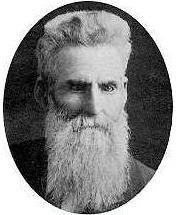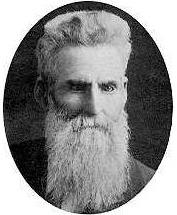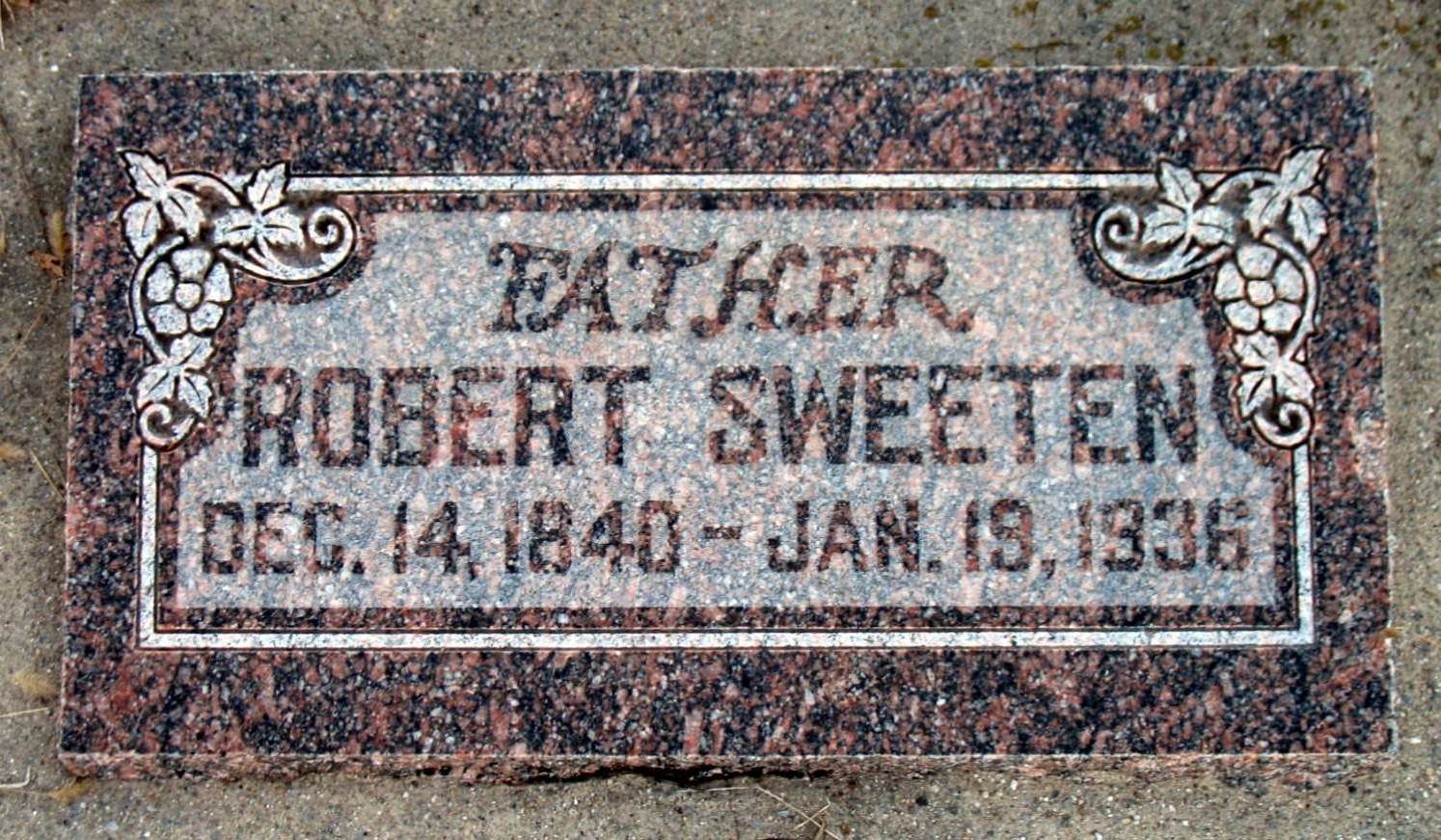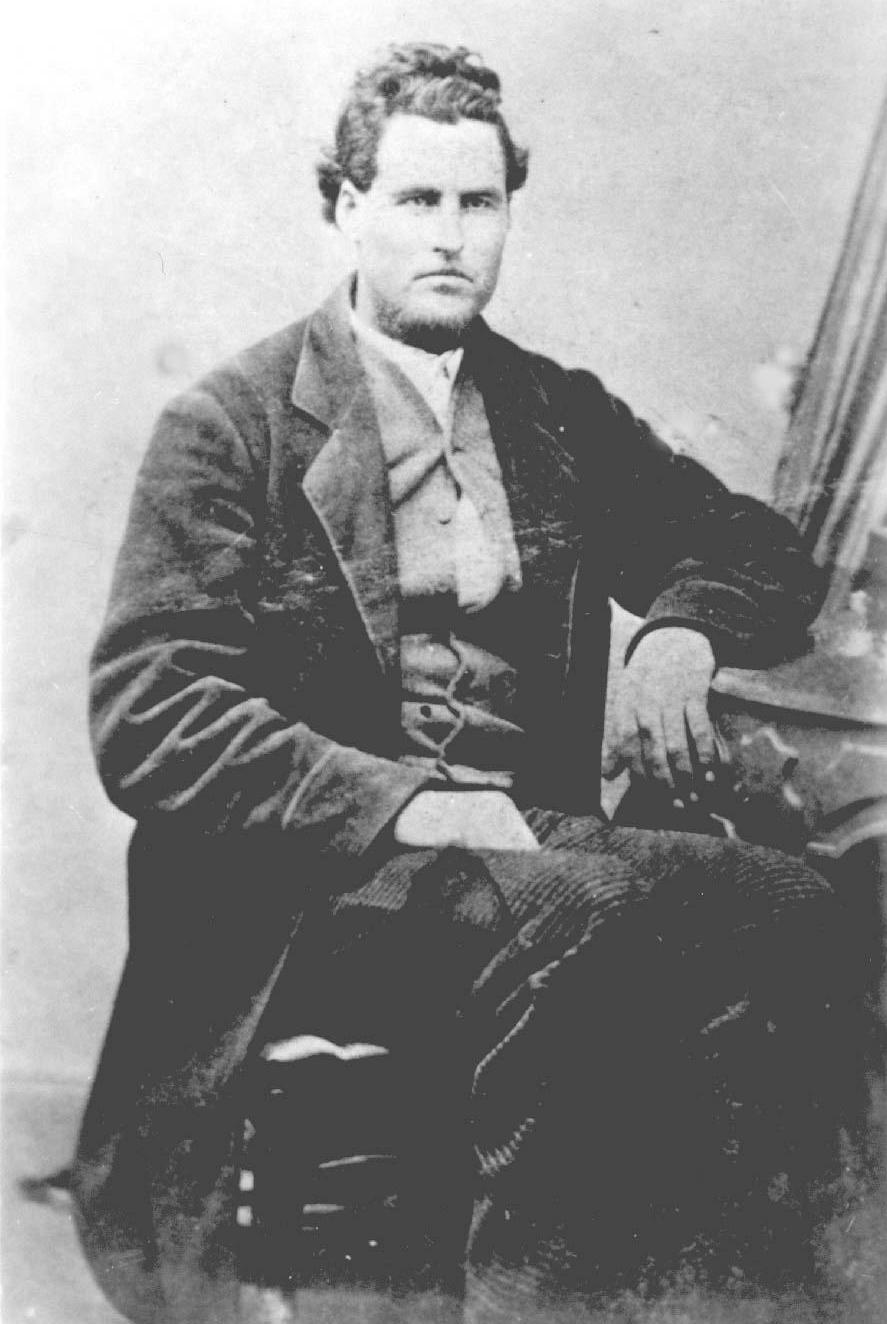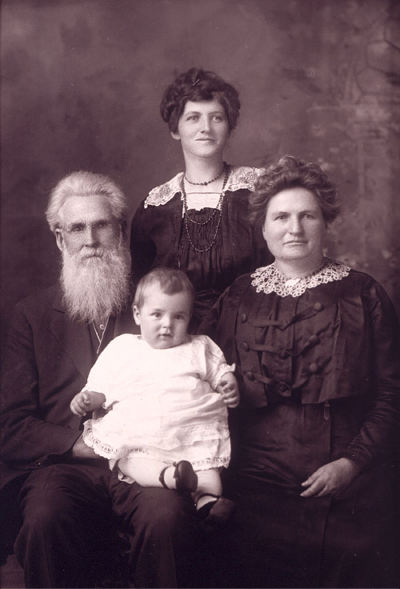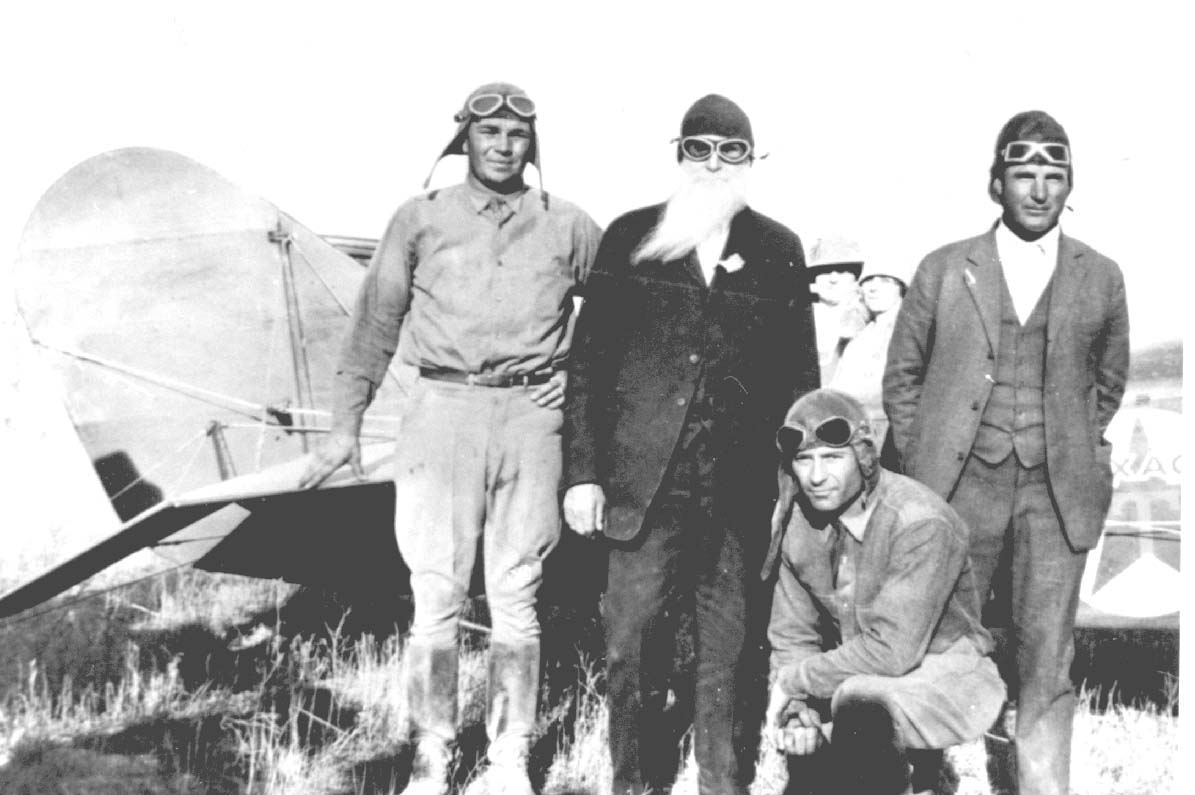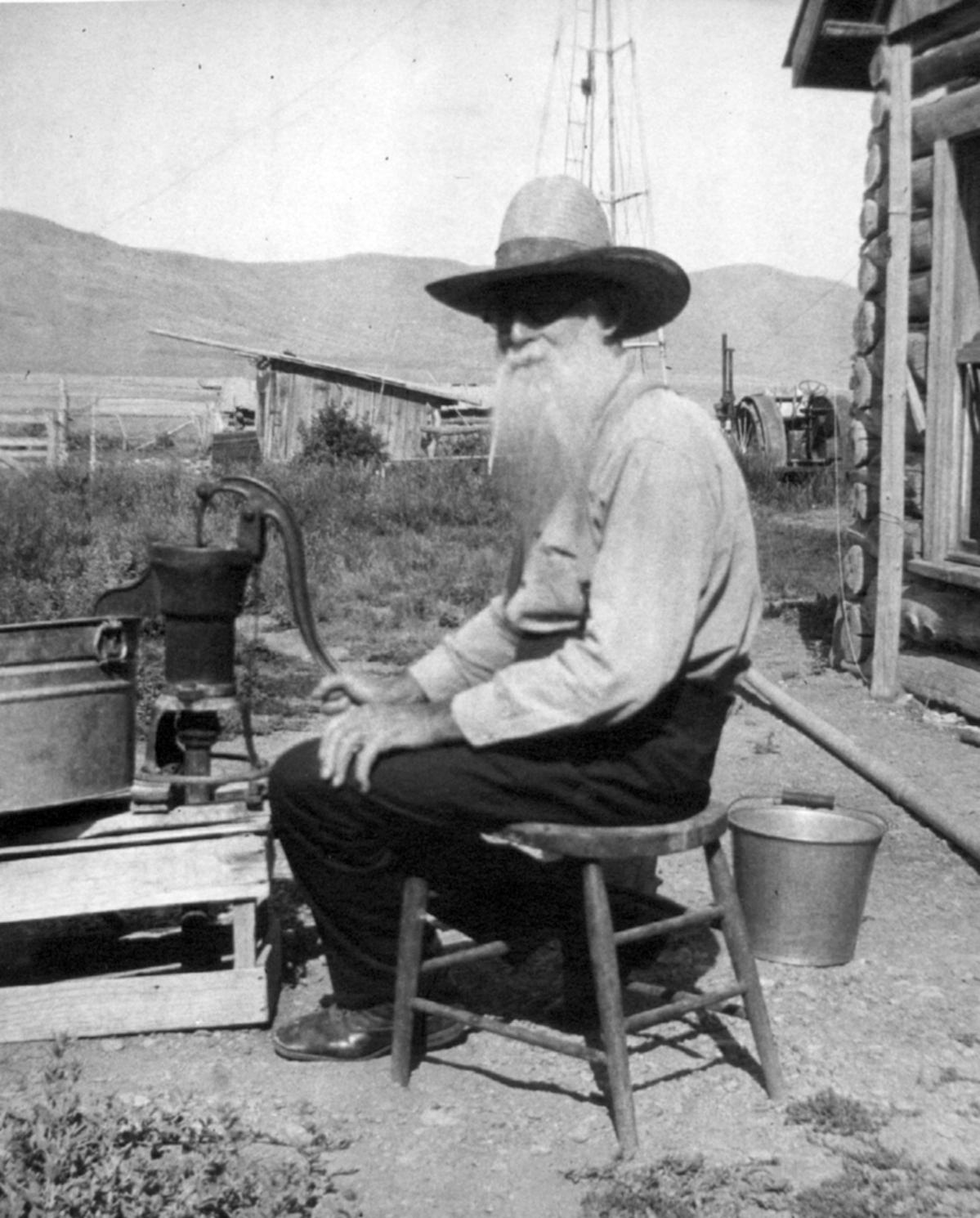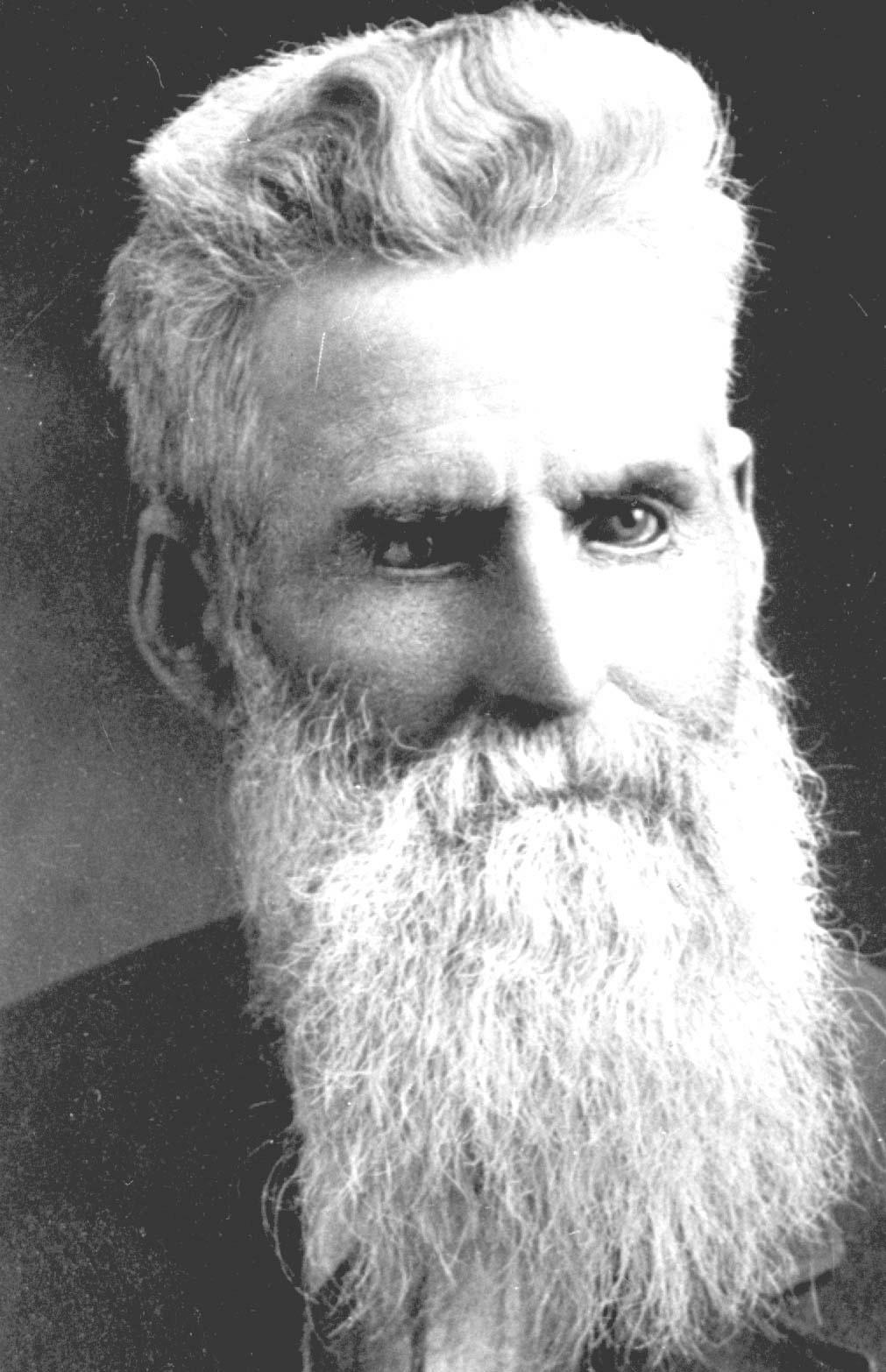Robert came to Utah Sept. 21, 1847 with mother and stepfather, Roger Luckham with the John Taylor company.
Married Amanda Hagle, Feb. 24, 1868, in Ontario, Canada, while there settling his father's estate. She came to Utah with her husband in 1870.
Children - Martha Emma Sweeten, Luke Sweeten, Robert Lorenzo Sweeten, Mary Amanda Sweeten, George Gillis Sweeten, Margaret Sweeten, Susan Idumea Sweeten, Colen Hagle Sweeten, Warren Hugh Sweeten, Alice Alberta Sweeten, Chloe Luetta Sweeten
Seventy. Settled in Salt Lake City; moved to Mill Creek, Salt Lake County, 1848 and to Mendon, Cache County, 1859. Member Mendon City Council 20 years. Director Mendon Co-op store, 15 years. Moved to Holbrook, Idaho, 1898. Justice of the Peace; City Marshal; Mayor two terms. Farmer.
Biography - Robert Sweeten was born December 14th, 1840, in Brooke, Ontario Canada, the son of George Sweeten and Mary Gardner. Two years later, on Christmas Eve, 1842 George Sweeten died, leaving his widow the care of two small children, Robert and an older sister Margaret.
Then the missionaries of a strange new faith visited the little Canadian settlement and the message they brought was welcomed by the young widow and her parents, Robert Gardner and Margaret Calinder and her brothers and sisters. Soon they were all baptized and became members of the Church of Jesus Christ of Latter-day Saints. Two younger brothers were soon ordained Elders and were set apart to preside over the newly formed Canadian Branch.
In 1844, Mary Gardner Sweeten married Roger Luckham, a young Englishman. To their union were born two daughters, Mary Luckham, who was born in their Canadian home, and Susannah Luckham, who was born in Salt Lake City in 1848. A desire to gather with the main body of the saints came upon the members of the Canadian Branch and led by Archibald and Robert Gardner, they set out for Nauvoo, Illinois. When they reached Nauvoo they found it a deserted city, with evidence of every side that the Saints had fled in haste. They caught up with the last of the line and continued on to Winter Quarters where they, with others, spent a winter of suffering and hardship.
In October 1847, they arrived in the Valley of the Great Salt Lake. Then followed years of toil and adventure and miracles long-remembered by the boy Robert and his sisters.
William Gardner, concerned with the business of establishing mills in this new country, had gone North into Cache Valley and had started building a mill at Gardner's Creek, two and one-half miles South of the present community of Mendon. In 1856, Mary and Roger Luckham and their family paid them a visit and were favorably impressed with the country and decided they would return and make their home there as soon a they could. They were not able to realize their ambition, for with the summer of 1857 came news of the approach of "Johnson's Army" and the order to move south. During this move, Robert's Mother suffered from exposure and as she had not been very strong since her illness while enroute to Utah, this additional exposure let to her death June 12, 1858, at Spanish Fork, Utah.
The next spring, Roger Luckham with his two daughters, Mary and Susannah and his stepson, Robert, now a lad of eighteen, arrived where the city of Mendon now stands. The following is from the journal of Daniel B. Hill Richards: "About May 1, 1859, Roger Luckham, his daughters Mary and Susannah and his step-son Robert Sweeten, two Englishmen, Charlie and Alfred Atkinson and their families, arrived where Mendon now stands. Following them in quick succession were James H. Hill, Isaac Sorensen and Peter Larsen, also of Millcreek and James G. Willie, who had been Bishop of the 8th Ward in Salt Lake City."
Robert was a tall, raw-boned type. He was not afraid of work and worked side by side with his stepfather and others in breaking land and planting crops. It wasn't long until these first settlers were followed by others and another community came into existence. In August 1859, John H. Richards and young Robert assisted a surveyor from Salt Lake City in laying out the plat for Mendon and adjoining farms. That winter the men spent their time getting logs from the canyon to build a community meeting place. At the suggestion of Heber C. Kimball, the settlement was named Mendon, in honor of Brigham Young's New York home.
In October 1862, Robert received word that his sister, Margaret, wife of Abraham Hunsaker, had passed away in Brigham City. He started at once, but as he left the canyon he could see the gathering at the Brigham Cemetery. He tried in vain to attract their attention so they would wait for him, but by the time he arrived the grave had been filled in. He always regretted that he didn't get to see his only full sister before she was buried.
In 1866, Robert found it necessary to return to Canada to settle a question of some real estate belonging to his father, George Sweeten. On this journey, which began by stagecoach, he had his first encounter with the iron horse of the railroad. The tracks had been laid as far as St. Joseph, Missouri. He said that at the first sight of the huge locomotive he jumped in the air and shouted, "a bear — a bear!" Up until that time a bear had been the most formidable object he had run into. It was also here that he tasted his first orange. Someone gave him one and neglected to tell him that he was supposed to peel it before he ate it. As a result, he had a low opinion of oranges for a long time. His main food for the trip was some hard cookies that he carried from home in a pillowcase. Unaccustomed to traveling as he was, he was always fearful of missing connections with the next ride. Suffice it to say he suffered from constipation ever after.
Until he returned to Canada he had always been content to go by his stepfathers' name. Now, if he were to be successful in proving himself the legal heir to his father's property, he must be known as Robert Sweeten, so he started signing his name as such.
One piece of land involved in the suits was in Brooke and the other near St. Thomas. One suit took place at London and the other at St. Thomas. His attorney was Phillip McKenzie. He was successful in establishing his identity as heir to the real estate. These lawsuits required considerable time and there were long periods of waiting. He secured work with Thomas Luckham, his stepfather's brother. At this time a young neighbor girl, Amanda Hagle, was helping Mrs. Luckham. As he helped her care for the milk and other household chores, Robert fell in love with her but she had other plans, as she was engaged to marry a local boy named George Harper. It took some time and considerable talking to change her mind, but Robert and Amanda were married on February 24, 1869. For a time they made their home in Canada, where their first child, Martha Emma, was born.
Life in Canada would have been comparatively easy for Robert Sweeten. The courts had declared him the legal heir to his father's property, which probably would have provided a comfortable income, but he was homesick for the West and anxious to return to Utah. He had the spirit of a true pioneer and was impatient to get back to where men were building up a new way of life. By this time the railroad had been completed and he and his wife and baby made the entire trip by train.
In the years that followed, he worked hard helping to build up the community of Mendon. He served as a member of the school board, was a member of the city council for nearly twenty years and for eight years was Mayor. Ten more children were born to the couple in their Mendon home. Amanda had been baptized into the church and both were active in religious as well as civic affairs.
The old two-story home was the center of much activity and housed many fond memories. Robert used to say that his children got their musical talent from him and that they got it all, that he didn't even keep enough to enable him to carry a tune. He did give them lots of encouragement and with the help of their more talented mother, all of the family developed considerable musical ability which they gave generously. They provided music for dances in their own and neighboring communities and assisted with the music in church gatherings and socials.
By 1898 Mendon was well established community and all the surrounding farm land had been taken up. The Sweeten boy had grown up and the family felt the need for expansion. The old farm West of town was dear to their hearts, but was not adequate to meet their increasing needs. Still full of the spirit of pioneering, Robert Sweeten and his boys set about looking for possible farm sites in virgin territory. They investigated the section about 25 miles West of Malad City and set about building a log cabin and clearing the sagebrush from their homestead sites.
For the next few years they traveled back and forth between their new farms and Mendon. Amanda spent much of her time looking after their Mendon interests while her husband helped clear the land. Two married daughters, Martha Holbrook and Mary (Mame) Atkinson and their husbands had also taken up claims there. The community was named Holbrook, after Martha's husband, Heber, who served as the first Bishop. The Sweeten's would spend the summers on the farm and return to Mendon for the winter months.
After their mother's death in the spring of 1903, the family leased their Mendon property to a neighbor and moved to Holbrook. Iduma and her husband, Wallace Cragun, had also moved there and had established a store.
Because of the wide experience he had already had in building up a community, Robert Sweeten was readily accepted as a counselor and leader in this new venture. His judgment was sound and he had courage and faith. He was always interested in bringing underground water to the surface and many of the early wells were dug at his insistence and under his direction.
Beards were the accepted thing in those days and his was an outstanding one. In his younger days it had a definite red coloring, but as the years passed his snowy white hair and long flowing white beard made him stand out in any crowd. At a pioneer day celebration in Logan, he was presented a watch for having the longest beard of all those present.
He developed a cataract on his eye and blindness was his lot the last twenty-odd years of his life. Although he could not see, he never lost interest in what was going on around him. Grandchildren would lead him around the yard to enable him to pump a bucket of water or do some chore he wanted to try his hand at. Once, while staying with Alberta, he set a bucket of water down and she found it balanced perfectly on top of a small glass.
He always tried to help. Even when age was telling on his stalwart body, he would turn the hand=powered washing machine or the big churn. Often he would dry the dishes. He loved to bounce the little ones on his "good foot" and was never so happy as when someone was combing his hair.
In his lifetime came most of the inventions that make modern-day living possible. He spent much of his time in Salt Lake with his daughter, Alberta, who was a widow. A radio, in the head phone/crystal stage, was a wonderful thing for him as it kept him informed of what was going on. Later, his family bought him a larger radio and he spent many hours listening and dozing. He loved to hear Ted Malone read poetry and one of his favorite programs was "Myrt and Marge." He met the leading characters once while a guest at KSL. They were amazed that a sightless man of his years would have such and interest in their program and know so much about it.
Somehow he always managed to have a sack of old-fashioned peppermints in his pocket. He could make them last an unbelievably long time in his own mouth, but was always free to dole them out one at a time to the small fry. He sat quietly until he could tell you were ready to clean where he was sitting, then with great effort would hold his feet up while you swept in front of his chair. The nearest he ever came to swearing was a forceful "Zounds."
Although unable to see, he enjoyed traveling. The trip from Salt Lake to Holbrook with him was always interesting as he had an uncanny ability to judge where we were. He talked about it as he remembered it and also as he thought it must look at the time.
At one time, he, in company with other pioneers, was permitted to fly back over part of the old pioneer trail he and walked as a boy. Numerous times in the last few years of his life he was honored with the remnant of the Pioneers of 1847. At the time of his death, he was the oldest of the group, which and dwindled to a half-a-dozen.
In 1935, he underwent an operation on his eye, hopeful that new methods would enable him to have a last look at things around him. To the disappointment of all, this was not his happy lot.
Death came January 19, 1936, in Salt Lake City, at the home of his granddaughter, Lucille. Funeral services were held in Salt Lake, January 22 and in Mendon the following day. As the procession entered Mendon, It was noticed that by strange coincidence, workmen were tearing down the old Sweeten home. The funeral was a lengthy one and it neared its' final stage, one of the speakers remarked to the effect that Robert hadn't been in any hurry to leave this life and that we shouldn't rush things with a short funeral.
His body was taken to the cemetery he had helped plan as a boy and placed in its' final resting place beside Amanda — his "Manda."
Mormon Pioneer Overland Travel, Edward Hunter - Joseph Horne Company (1847)
Robert came to Utah Sept. 21, 1847 with mother and stepfather, Roger Luckham with the John Taylor company.
Married Amanda Hagle, Feb. 24, 1868, in Ontario, Canada, while there settling his father's estate. She came to Utah with her husband in 1870.
Children - Martha Emma Sweeten, Luke Sweeten, Robert Lorenzo Sweeten, Mary Amanda Sweeten, George Gillis Sweeten, Margaret Sweeten, Susan Idumea Sweeten, Colen Hagle Sweeten, Warren Hugh Sweeten, Alice Alberta Sweeten, Chloe Luetta Sweeten
Seventy. Settled in Salt Lake City; moved to Mill Creek, Salt Lake County, 1848 and to Mendon, Cache County, 1859. Member Mendon City Council 20 years. Director Mendon Co-op store, 15 years. Moved to Holbrook, Idaho, 1898. Justice of the Peace; City Marshal; Mayor two terms. Farmer.
Biography - Robert Sweeten was born December 14th, 1840, in Brooke, Ontario Canada, the son of George Sweeten and Mary Gardner. Two years later, on Christmas Eve, 1842 George Sweeten died, leaving his widow the care of two small children, Robert and an older sister Margaret.
Then the missionaries of a strange new faith visited the little Canadian settlement and the message they brought was welcomed by the young widow and her parents, Robert Gardner and Margaret Calinder and her brothers and sisters. Soon they were all baptized and became members of the Church of Jesus Christ of Latter-day Saints. Two younger brothers were soon ordained Elders and were set apart to preside over the newly formed Canadian Branch.
In 1844, Mary Gardner Sweeten married Roger Luckham, a young Englishman. To their union were born two daughters, Mary Luckham, who was born in their Canadian home, and Susannah Luckham, who was born in Salt Lake City in 1848. A desire to gather with the main body of the saints came upon the members of the Canadian Branch and led by Archibald and Robert Gardner, they set out for Nauvoo, Illinois. When they reached Nauvoo they found it a deserted city, with evidence of every side that the Saints had fled in haste. They caught up with the last of the line and continued on to Winter Quarters where they, with others, spent a winter of suffering and hardship.
In October 1847, they arrived in the Valley of the Great Salt Lake. Then followed years of toil and adventure and miracles long-remembered by the boy Robert and his sisters.
William Gardner, concerned with the business of establishing mills in this new country, had gone North into Cache Valley and had started building a mill at Gardner's Creek, two and one-half miles South of the present community of Mendon. In 1856, Mary and Roger Luckham and their family paid them a visit and were favorably impressed with the country and decided they would return and make their home there as soon a they could. They were not able to realize their ambition, for with the summer of 1857 came news of the approach of "Johnson's Army" and the order to move south. During this move, Robert's Mother suffered from exposure and as she had not been very strong since her illness while enroute to Utah, this additional exposure let to her death June 12, 1858, at Spanish Fork, Utah.
The next spring, Roger Luckham with his two daughters, Mary and Susannah and his stepson, Robert, now a lad of eighteen, arrived where the city of Mendon now stands. The following is from the journal of Daniel B. Hill Richards: "About May 1, 1859, Roger Luckham, his daughters Mary and Susannah and his step-son Robert Sweeten, two Englishmen, Charlie and Alfred Atkinson and their families, arrived where Mendon now stands. Following them in quick succession were James H. Hill, Isaac Sorensen and Peter Larsen, also of Millcreek and James G. Willie, who had been Bishop of the 8th Ward in Salt Lake City."
Robert was a tall, raw-boned type. He was not afraid of work and worked side by side with his stepfather and others in breaking land and planting crops. It wasn't long until these first settlers were followed by others and another community came into existence. In August 1859, John H. Richards and young Robert assisted a surveyor from Salt Lake City in laying out the plat for Mendon and adjoining farms. That winter the men spent their time getting logs from the canyon to build a community meeting place. At the suggestion of Heber C. Kimball, the settlement was named Mendon, in honor of Brigham Young's New York home.
In October 1862, Robert received word that his sister, Margaret, wife of Abraham Hunsaker, had passed away in Brigham City. He started at once, but as he left the canyon he could see the gathering at the Brigham Cemetery. He tried in vain to attract their attention so they would wait for him, but by the time he arrived the grave had been filled in. He always regretted that he didn't get to see his only full sister before she was buried.
In 1866, Robert found it necessary to return to Canada to settle a question of some real estate belonging to his father, George Sweeten. On this journey, which began by stagecoach, he had his first encounter with the iron horse of the railroad. The tracks had been laid as far as St. Joseph, Missouri. He said that at the first sight of the huge locomotive he jumped in the air and shouted, "a bear — a bear!" Up until that time a bear had been the most formidable object he had run into. It was also here that he tasted his first orange. Someone gave him one and neglected to tell him that he was supposed to peel it before he ate it. As a result, he had a low opinion of oranges for a long time. His main food for the trip was some hard cookies that he carried from home in a pillowcase. Unaccustomed to traveling as he was, he was always fearful of missing connections with the next ride. Suffice it to say he suffered from constipation ever after.
Until he returned to Canada he had always been content to go by his stepfathers' name. Now, if he were to be successful in proving himself the legal heir to his father's property, he must be known as Robert Sweeten, so he started signing his name as such.
One piece of land involved in the suits was in Brooke and the other near St. Thomas. One suit took place at London and the other at St. Thomas. His attorney was Phillip McKenzie. He was successful in establishing his identity as heir to the real estate. These lawsuits required considerable time and there were long periods of waiting. He secured work with Thomas Luckham, his stepfather's brother. At this time a young neighbor girl, Amanda Hagle, was helping Mrs. Luckham. As he helped her care for the milk and other household chores, Robert fell in love with her but she had other plans, as she was engaged to marry a local boy named George Harper. It took some time and considerable talking to change her mind, but Robert and Amanda were married on February 24, 1869. For a time they made their home in Canada, where their first child, Martha Emma, was born.
Life in Canada would have been comparatively easy for Robert Sweeten. The courts had declared him the legal heir to his father's property, which probably would have provided a comfortable income, but he was homesick for the West and anxious to return to Utah. He had the spirit of a true pioneer and was impatient to get back to where men were building up a new way of life. By this time the railroad had been completed and he and his wife and baby made the entire trip by train.
In the years that followed, he worked hard helping to build up the community of Mendon. He served as a member of the school board, was a member of the city council for nearly twenty years and for eight years was Mayor. Ten more children were born to the couple in their Mendon home. Amanda had been baptized into the church and both were active in religious as well as civic affairs.
The old two-story home was the center of much activity and housed many fond memories. Robert used to say that his children got their musical talent from him and that they got it all, that he didn't even keep enough to enable him to carry a tune. He did give them lots of encouragement and with the help of their more talented mother, all of the family developed considerable musical ability which they gave generously. They provided music for dances in their own and neighboring communities and assisted with the music in church gatherings and socials.
By 1898 Mendon was well established community and all the surrounding farm land had been taken up. The Sweeten boy had grown up and the family felt the need for expansion. The old farm West of town was dear to their hearts, but was not adequate to meet their increasing needs. Still full of the spirit of pioneering, Robert Sweeten and his boys set about looking for possible farm sites in virgin territory. They investigated the section about 25 miles West of Malad City and set about building a log cabin and clearing the sagebrush from their homestead sites.
For the next few years they traveled back and forth between their new farms and Mendon. Amanda spent much of her time looking after their Mendon interests while her husband helped clear the land. Two married daughters, Martha Holbrook and Mary (Mame) Atkinson and their husbands had also taken up claims there. The community was named Holbrook, after Martha's husband, Heber, who served as the first Bishop. The Sweeten's would spend the summers on the farm and return to Mendon for the winter months.
After their mother's death in the spring of 1903, the family leased their Mendon property to a neighbor and moved to Holbrook. Iduma and her husband, Wallace Cragun, had also moved there and had established a store.
Because of the wide experience he had already had in building up a community, Robert Sweeten was readily accepted as a counselor and leader in this new venture. His judgment was sound and he had courage and faith. He was always interested in bringing underground water to the surface and many of the early wells were dug at his insistence and under his direction.
Beards were the accepted thing in those days and his was an outstanding one. In his younger days it had a definite red coloring, but as the years passed his snowy white hair and long flowing white beard made him stand out in any crowd. At a pioneer day celebration in Logan, he was presented a watch for having the longest beard of all those present.
He developed a cataract on his eye and blindness was his lot the last twenty-odd years of his life. Although he could not see, he never lost interest in what was going on around him. Grandchildren would lead him around the yard to enable him to pump a bucket of water or do some chore he wanted to try his hand at. Once, while staying with Alberta, he set a bucket of water down and she found it balanced perfectly on top of a small glass.
He always tried to help. Even when age was telling on his stalwart body, he would turn the hand=powered washing machine or the big churn. Often he would dry the dishes. He loved to bounce the little ones on his "good foot" and was never so happy as when someone was combing his hair.
In his lifetime came most of the inventions that make modern-day living possible. He spent much of his time in Salt Lake with his daughter, Alberta, who was a widow. A radio, in the head phone/crystal stage, was a wonderful thing for him as it kept him informed of what was going on. Later, his family bought him a larger radio and he spent many hours listening and dozing. He loved to hear Ted Malone read poetry and one of his favorite programs was "Myrt and Marge." He met the leading characters once while a guest at KSL. They were amazed that a sightless man of his years would have such and interest in their program and know so much about it.
Somehow he always managed to have a sack of old-fashioned peppermints in his pocket. He could make them last an unbelievably long time in his own mouth, but was always free to dole them out one at a time to the small fry. He sat quietly until he could tell you were ready to clean where he was sitting, then with great effort would hold his feet up while you swept in front of his chair. The nearest he ever came to swearing was a forceful "Zounds."
Although unable to see, he enjoyed traveling. The trip from Salt Lake to Holbrook with him was always interesting as he had an uncanny ability to judge where we were. He talked about it as he remembered it and also as he thought it must look at the time.
At one time, he, in company with other pioneers, was permitted to fly back over part of the old pioneer trail he and walked as a boy. Numerous times in the last few years of his life he was honored with the remnant of the Pioneers of 1847. At the time of his death, he was the oldest of the group, which and dwindled to a half-a-dozen.
In 1935, he underwent an operation on his eye, hopeful that new methods would enable him to have a last look at things around him. To the disappointment of all, this was not his happy lot.
Death came January 19, 1936, in Salt Lake City, at the home of his granddaughter, Lucille. Funeral services were held in Salt Lake, January 22 and in Mendon the following day. As the procession entered Mendon, It was noticed that by strange coincidence, workmen were tearing down the old Sweeten home. The funeral was a lengthy one and it neared its' final stage, one of the speakers remarked to the effect that Robert hadn't been in any hurry to leave this life and that we shouldn't rush things with a short funeral.
His body was taken to the cemetery he had helped plan as a boy and placed in its' final resting place beside Amanda — his "Manda."
Mormon Pioneer Overland Travel, Edward Hunter - Joseph Horne Company (1847)
Family Members
-
![]()
Martha Emma Sweeten Holbrook
1869–1945
-
![]()
Luke Sweeten
1871–1871
-
![]()
Robert Lorenzo Sweeten
1872–1956
-
![]()
Mary Amanda "Mame" Sweeten Atkinson
1873–1952
-
![]()
George Gillis "Gill" Sweeten
1876–1964
-
![]()
Margaret Sweeten
1878–1878
-
![]()
Susan Iduma "Duma" Sweeten Cragun
1879–1971
-
![]()
Colen Hagle Sweeten
1881–1971
-
![]()
Warren Hugh Sweeten
1883–1930
-
![]()
Alice Alberta Sweeten Barlow
1885–1943
-
![]()
Chloe Luetta Sweeten Sheriff
1888–1969
